Christian and Sikh Analysis of Case Study
VerifiedAdded on 2023/06/15
|10
|2956
|389
AI Summary
This essay is an ethical analysis of George’s situation based on the Christian and Sikh religion. The Christian and Sikh view of the value of life as a person. What will be morally justified in each situation? Personal view of the author.
Contribute Materials
Your contribution can guide someone’s learning journey. Share your
documents today.
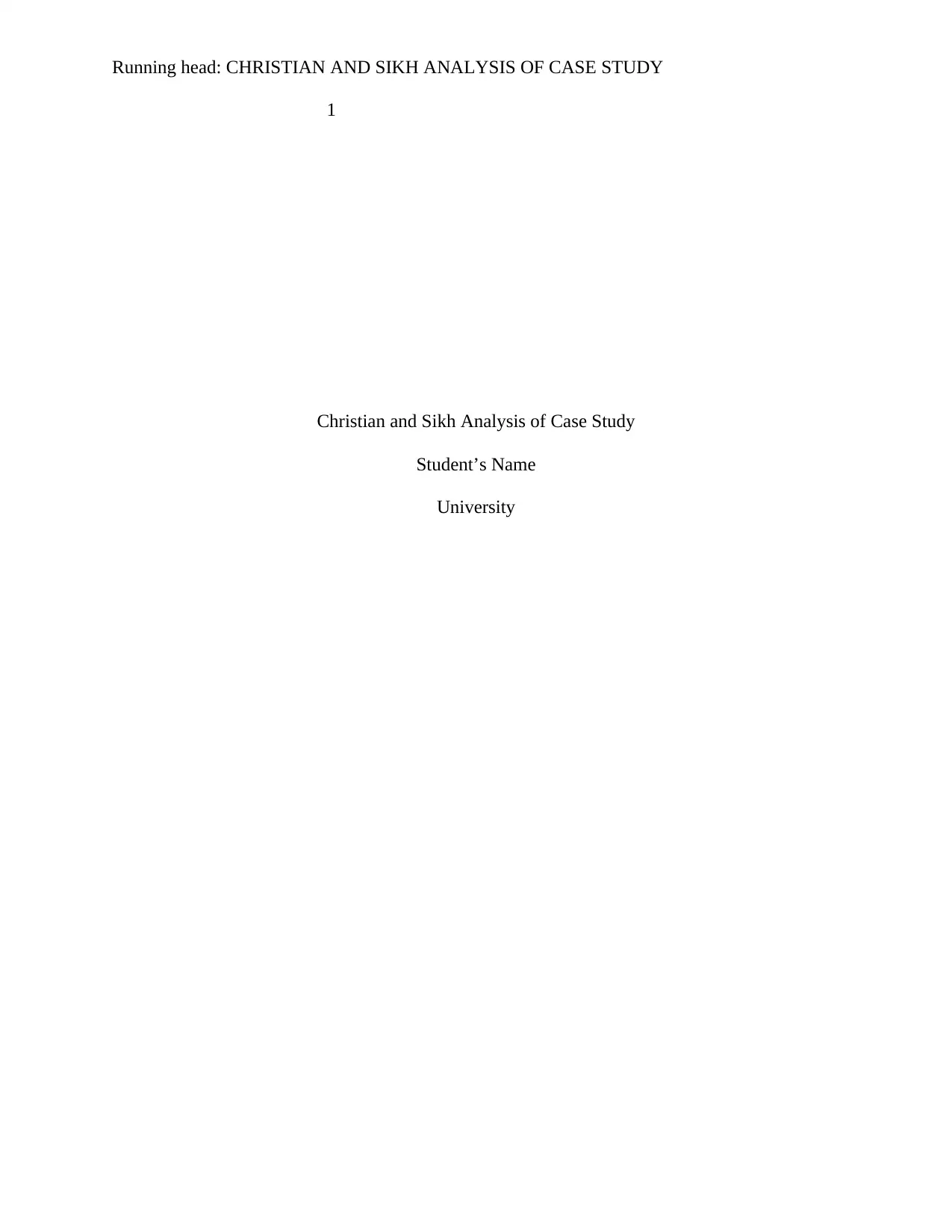
Running head: CHRISTIAN AND SIKH ANALYSIS OF CASE STUDY
1
Christian and Sikh Analysis of Case Study
Student’s Name
University
1
Christian and Sikh Analysis of Case Study
Student’s Name
University
Secure Best Marks with AI Grader
Need help grading? Try our AI Grader for instant feedback on your assignments.
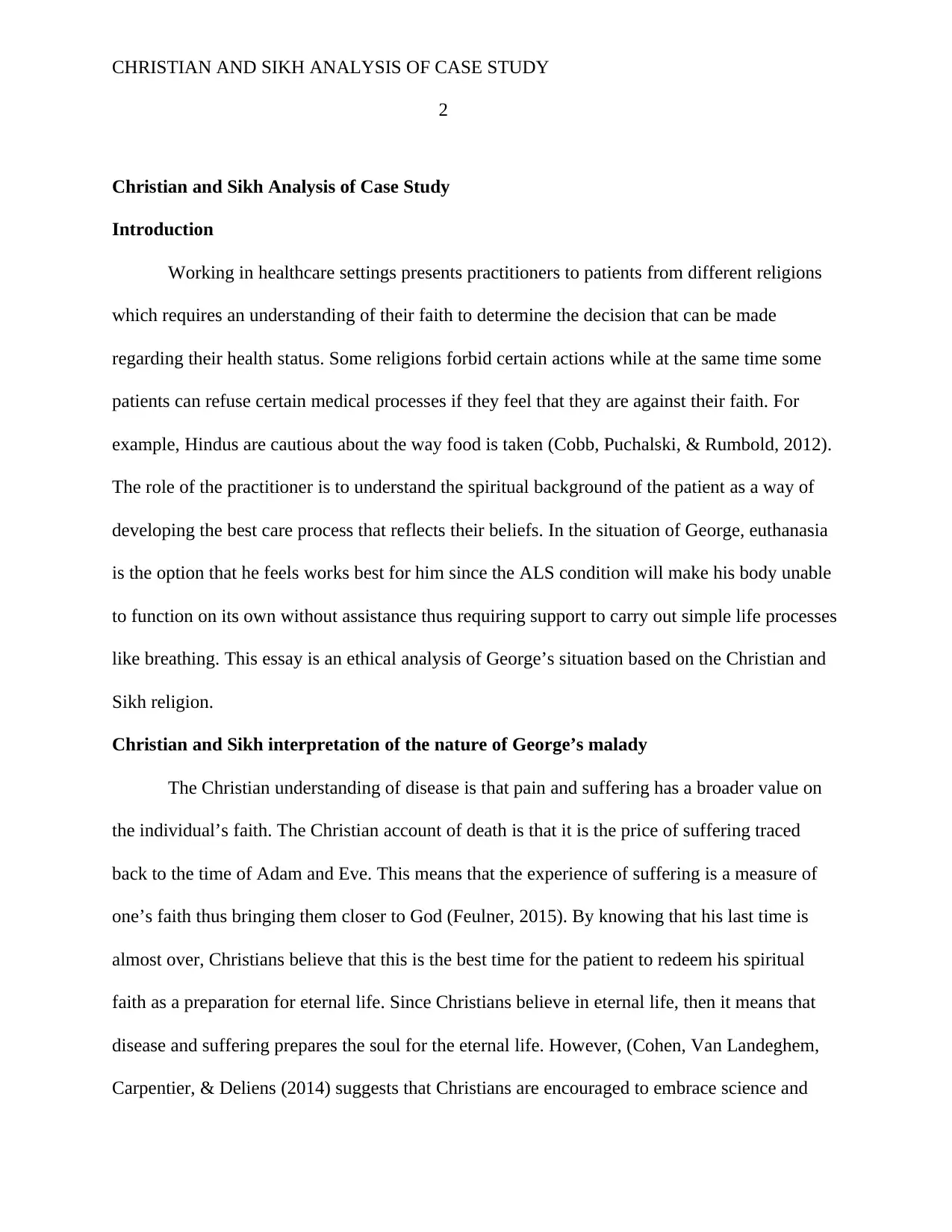
CHRISTIAN AND SIKH ANALYSIS OF CASE STUDY
2
Christian and Sikh Analysis of Case Study
Introduction
Working in healthcare settings presents practitioners to patients from different religions
which requires an understanding of their faith to determine the decision that can be made
regarding their health status. Some religions forbid certain actions while at the same time some
patients can refuse certain medical processes if they feel that they are against their faith. For
example, Hindus are cautious about the way food is taken (Cobb, Puchalski, & Rumbold, 2012).
The role of the practitioner is to understand the spiritual background of the patient as a way of
developing the best care process that reflects their beliefs. In the situation of George, euthanasia
is the option that he feels works best for him since the ALS condition will make his body unable
to function on its own without assistance thus requiring support to carry out simple life processes
like breathing. This essay is an ethical analysis of George’s situation based on the Christian and
Sikh religion.
Christian and Sikh interpretation of the nature of George’s malady
The Christian understanding of disease is that pain and suffering has a broader value on
the individual’s faith. The Christian account of death is that it is the price of suffering traced
back to the time of Adam and Eve. This means that the experience of suffering is a measure of
one’s faith thus bringing them closer to God (Feulner, 2015). By knowing that his last time is
almost over, Christians believe that this is the best time for the patient to redeem his spiritual
faith as a preparation for eternal life. Since Christians believe in eternal life, then it means that
disease and suffering prepares the soul for the eternal life. However, (Cohen, Van Landeghem,
Carpentier, & Deliens (2014) suggests that Christians are encouraged to embrace science and
2
Christian and Sikh Analysis of Case Study
Introduction
Working in healthcare settings presents practitioners to patients from different religions
which requires an understanding of their faith to determine the decision that can be made
regarding their health status. Some religions forbid certain actions while at the same time some
patients can refuse certain medical processes if they feel that they are against their faith. For
example, Hindus are cautious about the way food is taken (Cobb, Puchalski, & Rumbold, 2012).
The role of the practitioner is to understand the spiritual background of the patient as a way of
developing the best care process that reflects their beliefs. In the situation of George, euthanasia
is the option that he feels works best for him since the ALS condition will make his body unable
to function on its own without assistance thus requiring support to carry out simple life processes
like breathing. This essay is an ethical analysis of George’s situation based on the Christian and
Sikh religion.
Christian and Sikh interpretation of the nature of George’s malady
The Christian understanding of disease is that pain and suffering has a broader value on
the individual’s faith. The Christian account of death is that it is the price of suffering traced
back to the time of Adam and Eve. This means that the experience of suffering is a measure of
one’s faith thus bringing them closer to God (Feulner, 2015). By knowing that his last time is
almost over, Christians believe that this is the best time for the patient to redeem his spiritual
faith as a preparation for eternal life. Since Christians believe in eternal life, then it means that
disease and suffering prepares the soul for the eternal life. However, (Cohen, Van Landeghem,
Carpentier, & Deliens (2014) suggests that Christians are encouraged to embrace science and
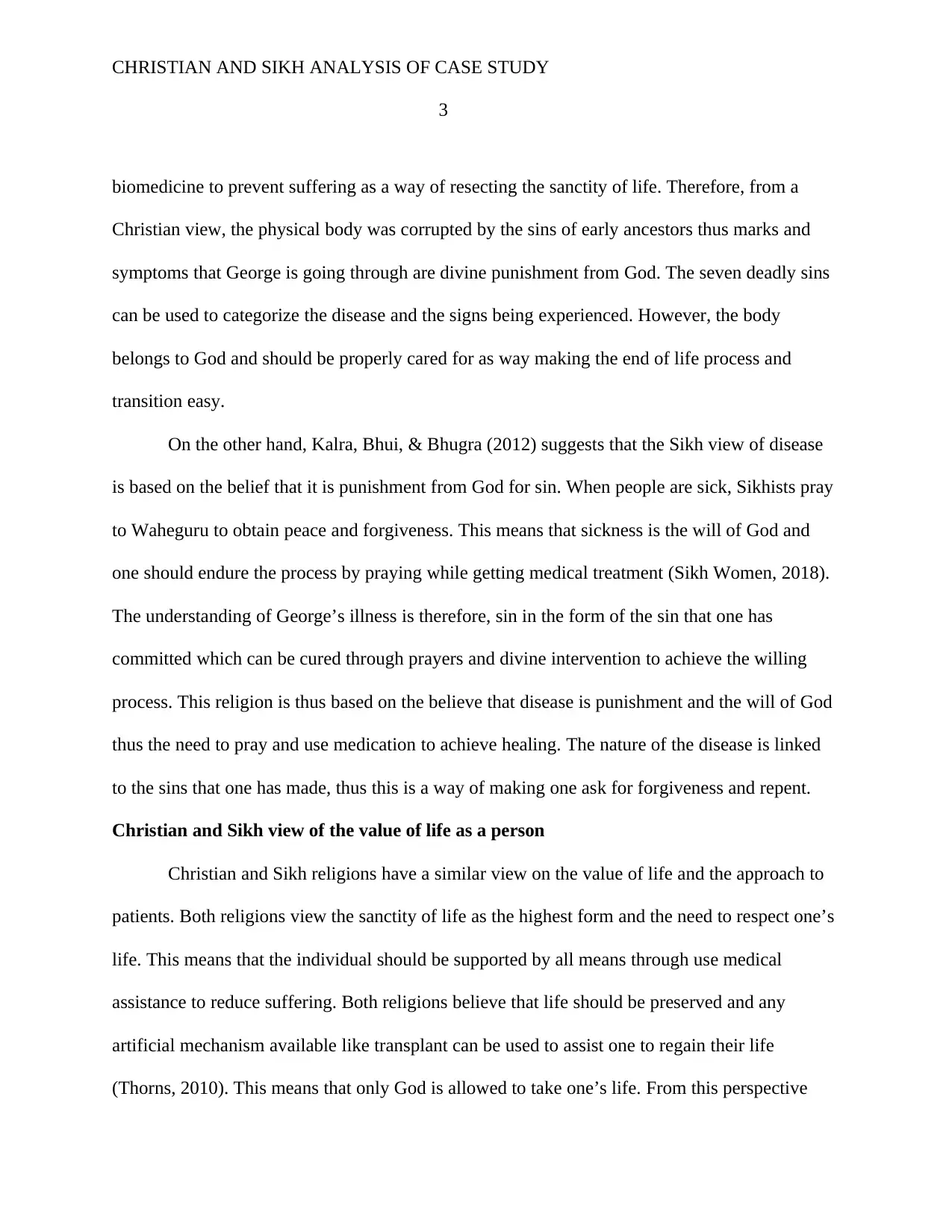
CHRISTIAN AND SIKH ANALYSIS OF CASE STUDY
3
biomedicine to prevent suffering as a way of resecting the sanctity of life. Therefore, from a
Christian view, the physical body was corrupted by the sins of early ancestors thus marks and
symptoms that George is going through are divine punishment from God. The seven deadly sins
can be used to categorize the disease and the signs being experienced. However, the body
belongs to God and should be properly cared for as way making the end of life process and
transition easy.
On the other hand, Kalra, Bhui, & Bhugra (2012) suggests that the Sikh view of disease
is based on the belief that it is punishment from God for sin. When people are sick, Sikhists pray
to Waheguru to obtain peace and forgiveness. This means that sickness is the will of God and
one should endure the process by praying while getting medical treatment (Sikh Women, 2018).
The understanding of George’s illness is therefore, sin in the form of the sin that one has
committed which can be cured through prayers and divine intervention to achieve the willing
process. This religion is thus based on the believe that disease is punishment and the will of God
thus the need to pray and use medication to achieve healing. The nature of the disease is linked
to the sins that one has made, thus this is a way of making one ask for forgiveness and repent.
Christian and Sikh view of the value of life as a person
Christian and Sikh religions have a similar view on the value of life and the approach to
patients. Both religions view the sanctity of life as the highest form and the need to respect one’s
life. This means that the individual should be supported by all means through use medical
assistance to reduce suffering. Both religions believe that life should be preserved and any
artificial mechanism available like transplant can be used to assist one to regain their life
(Thorns, 2010). This means that only God is allowed to take one’s life. From this perspective
3
biomedicine to prevent suffering as a way of resecting the sanctity of life. Therefore, from a
Christian view, the physical body was corrupted by the sins of early ancestors thus marks and
symptoms that George is going through are divine punishment from God. The seven deadly sins
can be used to categorize the disease and the signs being experienced. However, the body
belongs to God and should be properly cared for as way making the end of life process and
transition easy.
On the other hand, Kalra, Bhui, & Bhugra (2012) suggests that the Sikh view of disease
is based on the belief that it is punishment from God for sin. When people are sick, Sikhists pray
to Waheguru to obtain peace and forgiveness. This means that sickness is the will of God and
one should endure the process by praying while getting medical treatment (Sikh Women, 2018).
The understanding of George’s illness is therefore, sin in the form of the sin that one has
committed which can be cured through prayers and divine intervention to achieve the willing
process. This religion is thus based on the believe that disease is punishment and the will of God
thus the need to pray and use medication to achieve healing. The nature of the disease is linked
to the sins that one has made, thus this is a way of making one ask for forgiveness and repent.
Christian and Sikh view of the value of life as a person
Christian and Sikh religions have a similar view on the value of life and the approach to
patients. Both religions view the sanctity of life as the highest form and the need to respect one’s
life. This means that the individual should be supported by all means through use medical
assistance to reduce suffering. Both religions believe that life should be preserved and any
artificial mechanism available like transplant can be used to assist one to regain their life
(Thorns, 2010). This means that only God is allowed to take one’s life. From this perspective
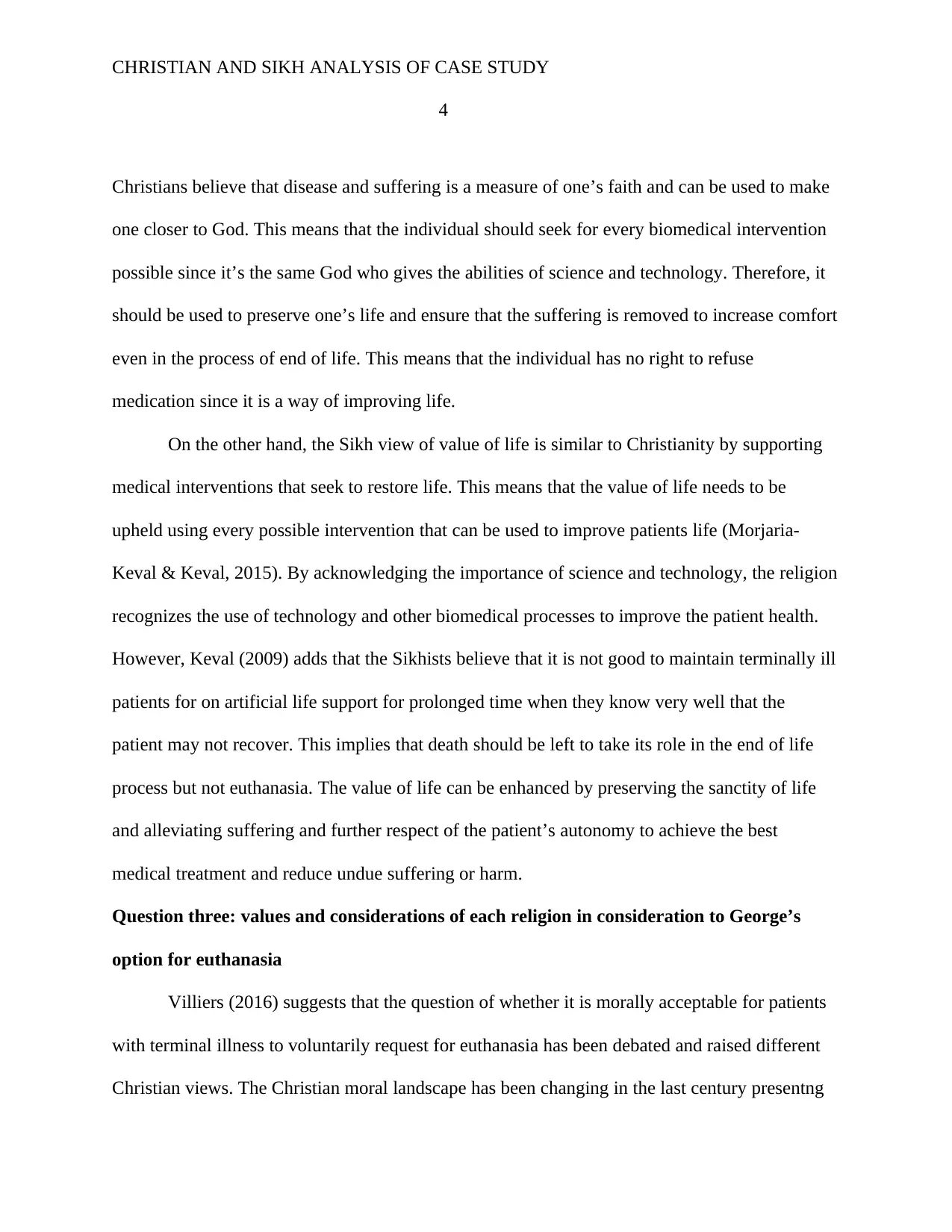
CHRISTIAN AND SIKH ANALYSIS OF CASE STUDY
4
Christians believe that disease and suffering is a measure of one’s faith and can be used to make
one closer to God. This means that the individual should seek for every biomedical intervention
possible since it’s the same God who gives the abilities of science and technology. Therefore, it
should be used to preserve one’s life and ensure that the suffering is removed to increase comfort
even in the process of end of life. This means that the individual has no right to refuse
medication since it is a way of improving life.
On the other hand, the Sikh view of value of life is similar to Christianity by supporting
medical interventions that seek to restore life. This means that the value of life needs to be
upheld using every possible intervention that can be used to improve patients life (Morjaria-
Keval & Keval, 2015). By acknowledging the importance of science and technology, the religion
recognizes the use of technology and other biomedical processes to improve the patient health.
However, Keval (2009) adds that the Sikhists believe that it is not good to maintain terminally ill
patients for on artificial life support for prolonged time when they know very well that the
patient may not recover. This implies that death should be left to take its role in the end of life
process but not euthanasia. The value of life can be enhanced by preserving the sanctity of life
and alleviating suffering and further respect of the patient’s autonomy to achieve the best
medical treatment and reduce undue suffering or harm.
Question three: values and considerations of each religion in consideration to George’s
option for euthanasia
Villiers (2016) suggests that the question of whether it is morally acceptable for patients
with terminal illness to voluntarily request for euthanasia has been debated and raised different
Christian views. The Christian moral landscape has been changing in the last century presentng
4
Christians believe that disease and suffering is a measure of one’s faith and can be used to make
one closer to God. This means that the individual should seek for every biomedical intervention
possible since it’s the same God who gives the abilities of science and technology. Therefore, it
should be used to preserve one’s life and ensure that the suffering is removed to increase comfort
even in the process of end of life. This means that the individual has no right to refuse
medication since it is a way of improving life.
On the other hand, the Sikh view of value of life is similar to Christianity by supporting
medical interventions that seek to restore life. This means that the value of life needs to be
upheld using every possible intervention that can be used to improve patients life (Morjaria-
Keval & Keval, 2015). By acknowledging the importance of science and technology, the religion
recognizes the use of technology and other biomedical processes to improve the patient health.
However, Keval (2009) adds that the Sikhists believe that it is not good to maintain terminally ill
patients for on artificial life support for prolonged time when they know very well that the
patient may not recover. This implies that death should be left to take its role in the end of life
process but not euthanasia. The value of life can be enhanced by preserving the sanctity of life
and alleviating suffering and further respect of the patient’s autonomy to achieve the best
medical treatment and reduce undue suffering or harm.
Question three: values and considerations of each religion in consideration to George’s
option for euthanasia
Villiers (2016) suggests that the question of whether it is morally acceptable for patients
with terminal illness to voluntarily request for euthanasia has been debated and raised different
Christian views. The Christian moral landscape has been changing in the last century presentng
Secure Best Marks with AI Grader
Need help grading? Try our AI Grader for instant feedback on your assignments.
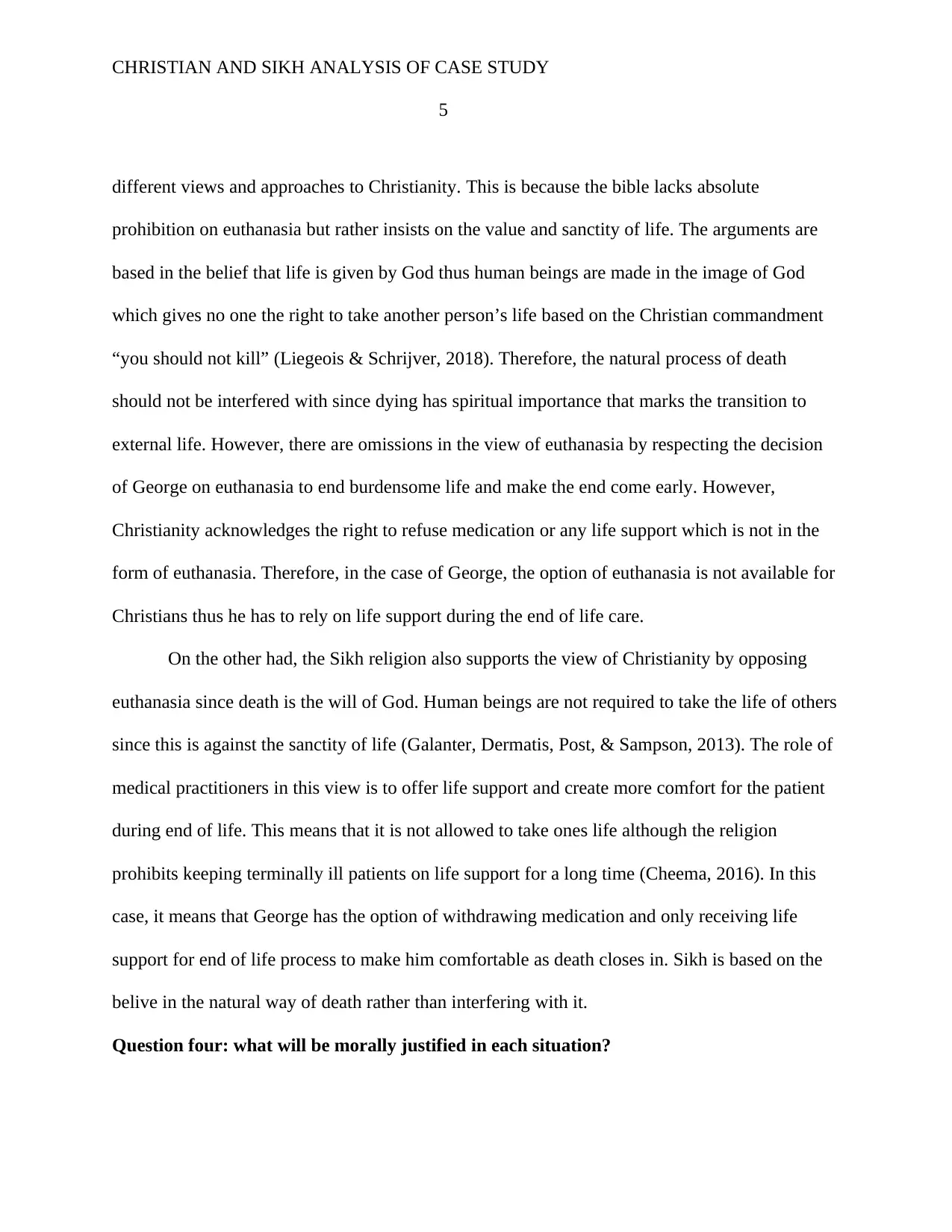
CHRISTIAN AND SIKH ANALYSIS OF CASE STUDY
5
different views and approaches to Christianity. This is because the bible lacks absolute
prohibition on euthanasia but rather insists on the value and sanctity of life. The arguments are
based in the belief that life is given by God thus human beings are made in the image of God
which gives no one the right to take another person’s life based on the Christian commandment
“you should not kill” (Liegeois & Schrijver, 2018). Therefore, the natural process of death
should not be interfered with since dying has spiritual importance that marks the transition to
external life. However, there are omissions in the view of euthanasia by respecting the decision
of George on euthanasia to end burdensome life and make the end come early. However,
Christianity acknowledges the right to refuse medication or any life support which is not in the
form of euthanasia. Therefore, in the case of George, the option of euthanasia is not available for
Christians thus he has to rely on life support during the end of life care.
On the other had, the Sikh religion also supports the view of Christianity by opposing
euthanasia since death is the will of God. Human beings are not required to take the life of others
since this is against the sanctity of life (Galanter, Dermatis, Post, & Sampson, 2013). The role of
medical practitioners in this view is to offer life support and create more comfort for the patient
during end of life. This means that it is not allowed to take ones life although the religion
prohibits keeping terminally ill patients on life support for a long time (Cheema, 2016). In this
case, it means that George has the option of withdrawing medication and only receiving life
support for end of life process to make him comfortable as death closes in. Sikh is based on the
belive in the natural way of death rather than interfering with it.
Question four: what will be morally justified in each situation?
5
different views and approaches to Christianity. This is because the bible lacks absolute
prohibition on euthanasia but rather insists on the value and sanctity of life. The arguments are
based in the belief that life is given by God thus human beings are made in the image of God
which gives no one the right to take another person’s life based on the Christian commandment
“you should not kill” (Liegeois & Schrijver, 2018). Therefore, the natural process of death
should not be interfered with since dying has spiritual importance that marks the transition to
external life. However, there are omissions in the view of euthanasia by respecting the decision
of George on euthanasia to end burdensome life and make the end come early. However,
Christianity acknowledges the right to refuse medication or any life support which is not in the
form of euthanasia. Therefore, in the case of George, the option of euthanasia is not available for
Christians thus he has to rely on life support during the end of life care.
On the other had, the Sikh religion also supports the view of Christianity by opposing
euthanasia since death is the will of God. Human beings are not required to take the life of others
since this is against the sanctity of life (Galanter, Dermatis, Post, & Sampson, 2013). The role of
medical practitioners in this view is to offer life support and create more comfort for the patient
during end of life. This means that it is not allowed to take ones life although the religion
prohibits keeping terminally ill patients on life support for a long time (Cheema, 2016). In this
case, it means that George has the option of withdrawing medication and only receiving life
support for end of life process to make him comfortable as death closes in. Sikh is based on the
belive in the natural way of death rather than interfering with it.
Question four: what will be morally justified in each situation?
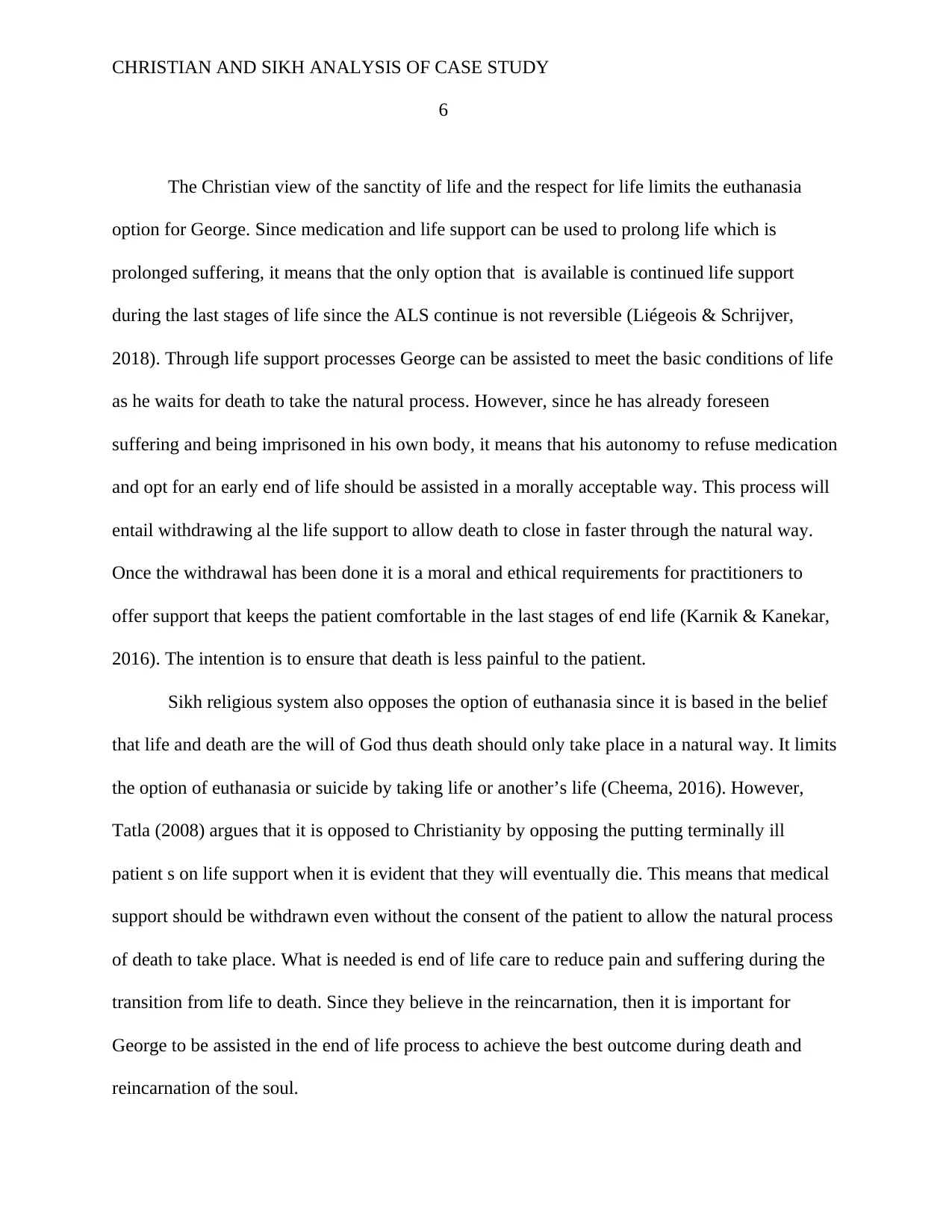
CHRISTIAN AND SIKH ANALYSIS OF CASE STUDY
6
The Christian view of the sanctity of life and the respect for life limits the euthanasia
option for George. Since medication and life support can be used to prolong life which is
prolonged suffering, it means that the only option that is available is continued life support
during the last stages of life since the ALS continue is not reversible (Liégeois & Schrijver,
2018). Through life support processes George can be assisted to meet the basic conditions of life
as he waits for death to take the natural process. However, since he has already foreseen
suffering and being imprisoned in his own body, it means that his autonomy to refuse medication
and opt for an early end of life should be assisted in a morally acceptable way. This process will
entail withdrawing al the life support to allow death to close in faster through the natural way.
Once the withdrawal has been done it is a moral and ethical requirements for practitioners to
offer support that keeps the patient comfortable in the last stages of end life (Karnik & Kanekar,
2016). The intention is to ensure that death is less painful to the patient.
Sikh religious system also opposes the option of euthanasia since it is based in the belief
that life and death are the will of God thus death should only take place in a natural way. It limits
the option of euthanasia or suicide by taking life or another’s life (Cheema, 2016). However,
Tatla (2008) argues that it is opposed to Christianity by opposing the putting terminally ill
patient s on life support when it is evident that they will eventually die. This means that medical
support should be withdrawn even without the consent of the patient to allow the natural process
of death to take place. What is needed is end of life care to reduce pain and suffering during the
transition from life to death. Since they believe in the reincarnation, then it is important for
George to be assisted in the end of life process to achieve the best outcome during death and
reincarnation of the soul.
6
The Christian view of the sanctity of life and the respect for life limits the euthanasia
option for George. Since medication and life support can be used to prolong life which is
prolonged suffering, it means that the only option that is available is continued life support
during the last stages of life since the ALS continue is not reversible (Liégeois & Schrijver,
2018). Through life support processes George can be assisted to meet the basic conditions of life
as he waits for death to take the natural process. However, since he has already foreseen
suffering and being imprisoned in his own body, it means that his autonomy to refuse medication
and opt for an early end of life should be assisted in a morally acceptable way. This process will
entail withdrawing al the life support to allow death to close in faster through the natural way.
Once the withdrawal has been done it is a moral and ethical requirements for practitioners to
offer support that keeps the patient comfortable in the last stages of end life (Karnik & Kanekar,
2016). The intention is to ensure that death is less painful to the patient.
Sikh religious system also opposes the option of euthanasia since it is based in the belief
that life and death are the will of God thus death should only take place in a natural way. It limits
the option of euthanasia or suicide by taking life or another’s life (Cheema, 2016). However,
Tatla (2008) argues that it is opposed to Christianity by opposing the putting terminally ill
patient s on life support when it is evident that they will eventually die. This means that medical
support should be withdrawn even without the consent of the patient to allow the natural process
of death to take place. What is needed is end of life care to reduce pain and suffering during the
transition from life to death. Since they believe in the reincarnation, then it is important for
George to be assisted in the end of life process to achieve the best outcome during death and
reincarnation of the soul.
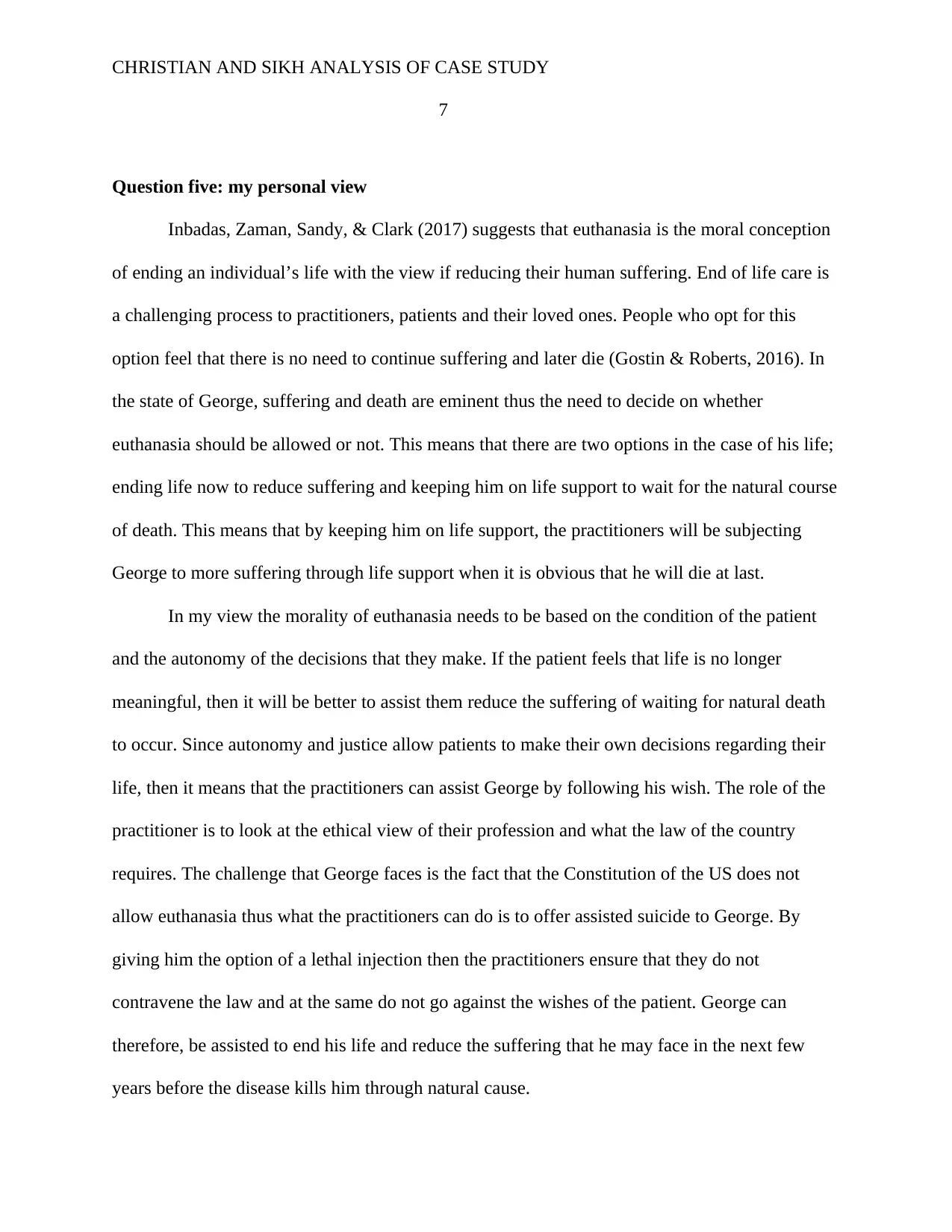
CHRISTIAN AND SIKH ANALYSIS OF CASE STUDY
7
Question five: my personal view
Inbadas, Zaman, Sandy, & Clark (2017) suggests that euthanasia is the moral conception
of ending an individual’s life with the view if reducing their human suffering. End of life care is
a challenging process to practitioners, patients and their loved ones. People who opt for this
option feel that there is no need to continue suffering and later die (Gostin & Roberts, 2016). In
the state of George, suffering and death are eminent thus the need to decide on whether
euthanasia should be allowed or not. This means that there are two options in the case of his life;
ending life now to reduce suffering and keeping him on life support to wait for the natural course
of death. This means that by keeping him on life support, the practitioners will be subjecting
George to more suffering through life support when it is obvious that he will die at last.
In my view the morality of euthanasia needs to be based on the condition of the patient
and the autonomy of the decisions that they make. If the patient feels that life is no longer
meaningful, then it will be better to assist them reduce the suffering of waiting for natural death
to occur. Since autonomy and justice allow patients to make their own decisions regarding their
life, then it means that the practitioners can assist George by following his wish. The role of the
practitioner is to look at the ethical view of their profession and what the law of the country
requires. The challenge that George faces is the fact that the Constitution of the US does not
allow euthanasia thus what the practitioners can do is to offer assisted suicide to George. By
giving him the option of a lethal injection then the practitioners ensure that they do not
contravene the law and at the same do not go against the wishes of the patient. George can
therefore, be assisted to end his life and reduce the suffering that he may face in the next few
years before the disease kills him through natural cause.
7
Question five: my personal view
Inbadas, Zaman, Sandy, & Clark (2017) suggests that euthanasia is the moral conception
of ending an individual’s life with the view if reducing their human suffering. End of life care is
a challenging process to practitioners, patients and their loved ones. People who opt for this
option feel that there is no need to continue suffering and later die (Gostin & Roberts, 2016). In
the state of George, suffering and death are eminent thus the need to decide on whether
euthanasia should be allowed or not. This means that there are two options in the case of his life;
ending life now to reduce suffering and keeping him on life support to wait for the natural course
of death. This means that by keeping him on life support, the practitioners will be subjecting
George to more suffering through life support when it is obvious that he will die at last.
In my view the morality of euthanasia needs to be based on the condition of the patient
and the autonomy of the decisions that they make. If the patient feels that life is no longer
meaningful, then it will be better to assist them reduce the suffering of waiting for natural death
to occur. Since autonomy and justice allow patients to make their own decisions regarding their
life, then it means that the practitioners can assist George by following his wish. The role of the
practitioner is to look at the ethical view of their profession and what the law of the country
requires. The challenge that George faces is the fact that the Constitution of the US does not
allow euthanasia thus what the practitioners can do is to offer assisted suicide to George. By
giving him the option of a lethal injection then the practitioners ensure that they do not
contravene the law and at the same do not go against the wishes of the patient. George can
therefore, be assisted to end his life and reduce the suffering that he may face in the next few
years before the disease kills him through natural cause.
Paraphrase This Document
Need a fresh take? Get an instant paraphrase of this document with our AI Paraphraser
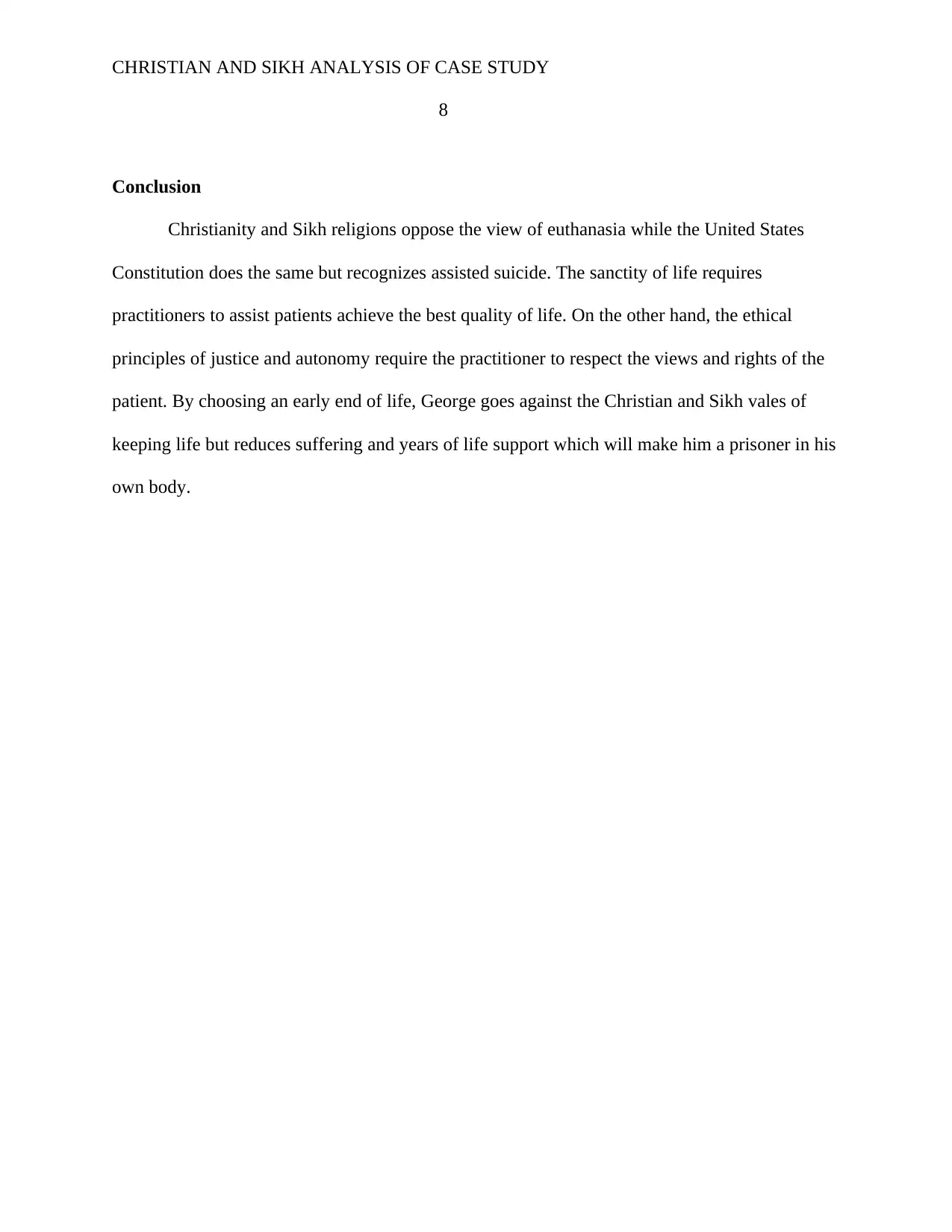
CHRISTIAN AND SIKH ANALYSIS OF CASE STUDY
8
Conclusion
Christianity and Sikh religions oppose the view of euthanasia while the United States
Constitution does the same but recognizes assisted suicide. The sanctity of life requires
practitioners to assist patients achieve the best quality of life. On the other hand, the ethical
principles of justice and autonomy require the practitioner to respect the views and rights of the
patient. By choosing an early end of life, George goes against the Christian and Sikh vales of
keeping life but reduces suffering and years of life support which will make him a prisoner in his
own body.
8
Conclusion
Christianity and Sikh religions oppose the view of euthanasia while the United States
Constitution does the same but recognizes assisted suicide. The sanctity of life requires
practitioners to assist patients achieve the best quality of life. On the other hand, the ethical
principles of justice and autonomy require the practitioner to respect the views and rights of the
patient. By choosing an early end of life, George goes against the Christian and Sikh vales of
keeping life but reduces suffering and years of life support which will make him a prisoner in his
own body.
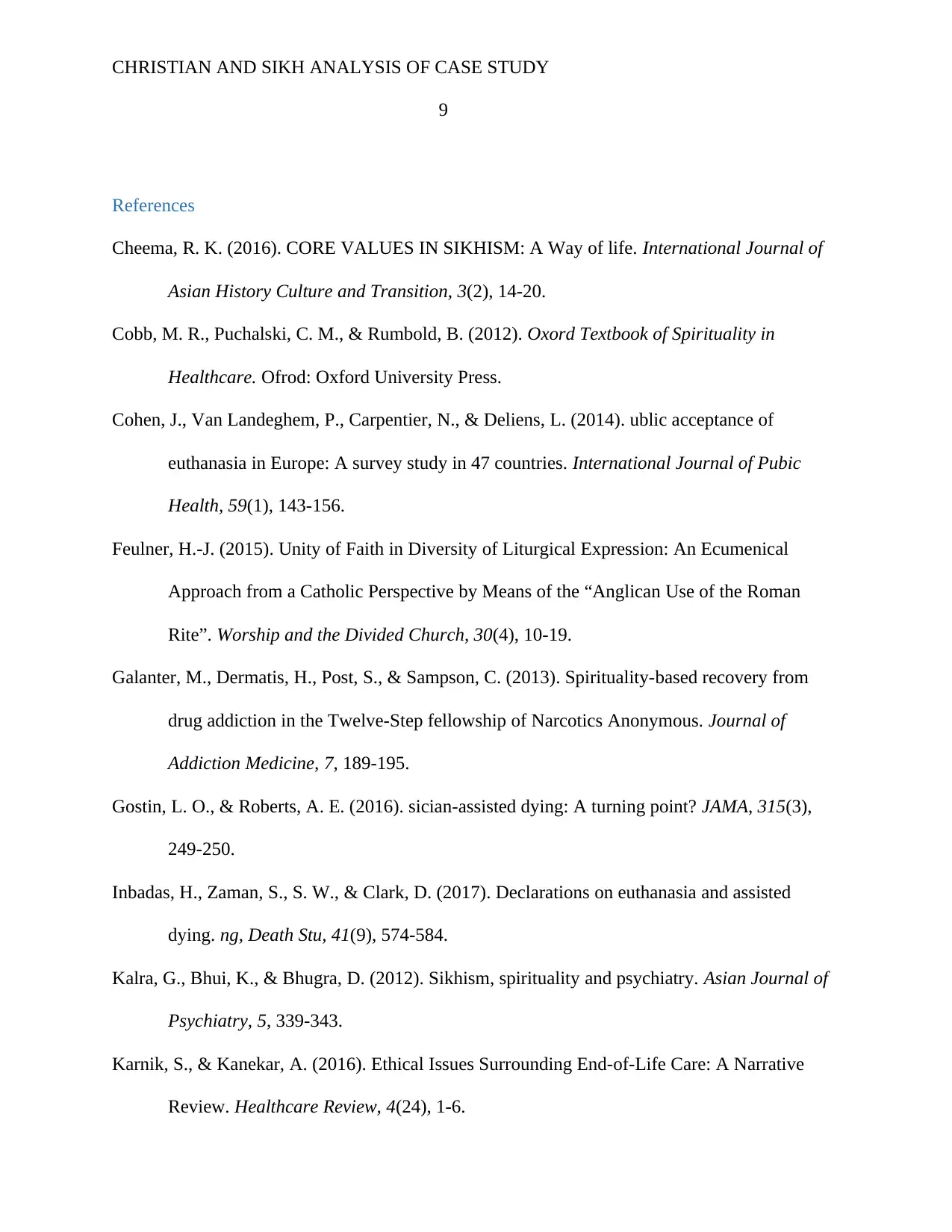
CHRISTIAN AND SIKH ANALYSIS OF CASE STUDY
9
References
Cheema, R. K. (2016). CORE VALUES IN SIKHISM: A Way of life. International Journal of
Asian History Culture and Transition, 3(2), 14-20.
Cobb, M. R., Puchalski, C. M., & Rumbold, B. (2012). Oxord Textbook of Spirituality in
Healthcare. Ofrod: Oxford University Press.
Cohen, J., Van Landeghem, P., Carpentier, N., & Deliens, L. (2014). ublic acceptance of
euthanasia in Europe: A survey study in 47 countries. International Journal of Pubic
Health, 59(1), 143-156.
Feulner, H.-J. (2015). Unity of Faith in Diversity of Liturgical Expression: An Ecumenical
Approach from a Catholic Perspective by Means of the “Anglican Use of the Roman
Rite”. Worship and the Divided Church, 30(4), 10-19.
Galanter, M., Dermatis, H., Post, S., & Sampson, C. (2013). Spirituality-based recovery from
drug addiction in the Twelve-Step fellowship of Narcotics Anonymous. Journal of
Addiction Medicine, 7, 189-195.
Gostin, L. O., & Roberts, A. E. (2016). sician-assisted dying: A turning point? JAMA, 315(3),
249-250.
Inbadas, H., Zaman, S., S. W., & Clark, D. (2017). Declarations on euthanasia and assisted
dying. ng, Death Stu, 41(9), 574-584.
Kalra, G., Bhui, K., & Bhugra, D. (2012). Sikhism, spirituality and psychiatry. Asian Journal of
Psychiatry, 5, 339-343.
Karnik, S., & Kanekar, A. (2016). Ethical Issues Surrounding End-of-Life Care: A Narrative
Review. Healthcare Review, 4(24), 1-6.
9
References
Cheema, R. K. (2016). CORE VALUES IN SIKHISM: A Way of life. International Journal of
Asian History Culture and Transition, 3(2), 14-20.
Cobb, M. R., Puchalski, C. M., & Rumbold, B. (2012). Oxord Textbook of Spirituality in
Healthcare. Ofrod: Oxford University Press.
Cohen, J., Van Landeghem, P., Carpentier, N., & Deliens, L. (2014). ublic acceptance of
euthanasia in Europe: A survey study in 47 countries. International Journal of Pubic
Health, 59(1), 143-156.
Feulner, H.-J. (2015). Unity of Faith in Diversity of Liturgical Expression: An Ecumenical
Approach from a Catholic Perspective by Means of the “Anglican Use of the Roman
Rite”. Worship and the Divided Church, 30(4), 10-19.
Galanter, M., Dermatis, H., Post, S., & Sampson, C. (2013). Spirituality-based recovery from
drug addiction in the Twelve-Step fellowship of Narcotics Anonymous. Journal of
Addiction Medicine, 7, 189-195.
Gostin, L. O., & Roberts, A. E. (2016). sician-assisted dying: A turning point? JAMA, 315(3),
249-250.
Inbadas, H., Zaman, S., S. W., & Clark, D. (2017). Declarations on euthanasia and assisted
dying. ng, Death Stu, 41(9), 574-584.
Kalra, G., Bhui, K., & Bhugra, D. (2012). Sikhism, spirituality and psychiatry. Asian Journal of
Psychiatry, 5, 339-343.
Karnik, S., & Kanekar, A. (2016). Ethical Issues Surrounding End-of-Life Care: A Narrative
Review. Healthcare Review, 4(24), 1-6.
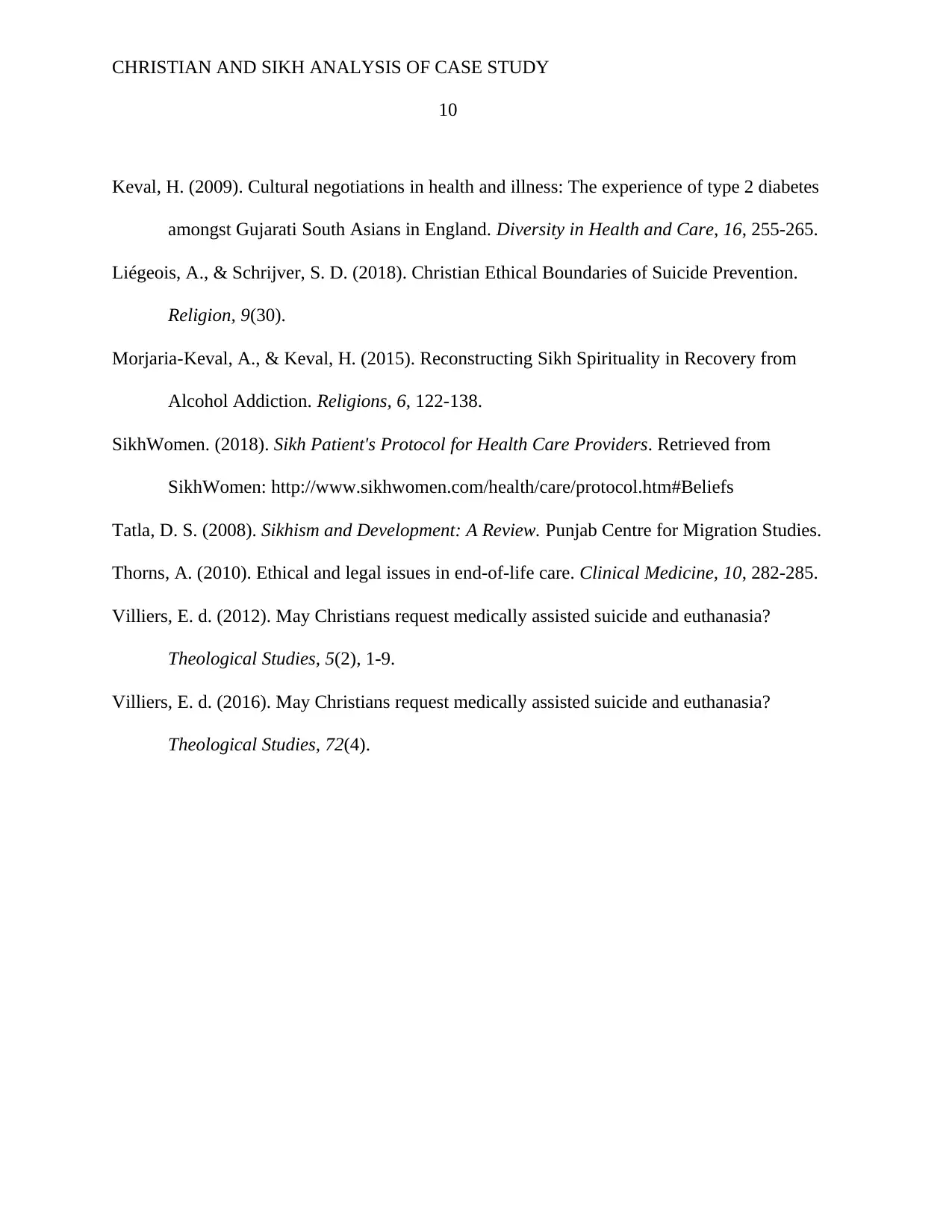
CHRISTIAN AND SIKH ANALYSIS OF CASE STUDY
10
Keval, H. (2009). Cultural negotiations in health and illness: The experience of type 2 diabetes
amongst Gujarati South Asians in England. Diversity in Health and Care, 16, 255-265.
Liégeois, A., & Schrijver, S. D. (2018). Christian Ethical Boundaries of Suicide Prevention.
Religion, 9(30).
Morjaria-Keval, A., & Keval, H. (2015). Reconstructing Sikh Spirituality in Recovery from
Alcohol Addiction. Religions, 6, 122-138.
SikhWomen. (2018). Sikh Patient's Protocol for Health Care Providers. Retrieved from
SikhWomen: http://www.sikhwomen.com/health/care/protocol.htm#Beliefs
Tatla, D. S. (2008). Sikhism and Development: A Review. Punjab Centre for Migration Studies.
Thorns, A. (2010). Ethical and legal issues in end-of-life care. Clinical Medicine, 10, 282-285.
Villiers, E. d. (2012). May Christians request medically assisted suicide and euthanasia?
Theological Studies, 5(2), 1-9.
Villiers, E. d. (2016). May Christians request medically assisted suicide and euthanasia?
Theological Studies, 72(4).
10
Keval, H. (2009). Cultural negotiations in health and illness: The experience of type 2 diabetes
amongst Gujarati South Asians in England. Diversity in Health and Care, 16, 255-265.
Liégeois, A., & Schrijver, S. D. (2018). Christian Ethical Boundaries of Suicide Prevention.
Religion, 9(30).
Morjaria-Keval, A., & Keval, H. (2015). Reconstructing Sikh Spirituality in Recovery from
Alcohol Addiction. Religions, 6, 122-138.
SikhWomen. (2018). Sikh Patient's Protocol for Health Care Providers. Retrieved from
SikhWomen: http://www.sikhwomen.com/health/care/protocol.htm#Beliefs
Tatla, D. S. (2008). Sikhism and Development: A Review. Punjab Centre for Migration Studies.
Thorns, A. (2010). Ethical and legal issues in end-of-life care. Clinical Medicine, 10, 282-285.
Villiers, E. d. (2012). May Christians request medically assisted suicide and euthanasia?
Theological Studies, 5(2), 1-9.
Villiers, E. d. (2016). May Christians request medically assisted suicide and euthanasia?
Theological Studies, 72(4).
1 out of 10
Related Documents
Your All-in-One AI-Powered Toolkit for Academic Success.
+13062052269
info@desklib.com
Available 24*7 on WhatsApp / Email
![[object Object]](/_next/static/media/star-bottom.7253800d.svg)
Unlock your academic potential
© 2024 | Zucol Services PVT LTD | All rights reserved.





